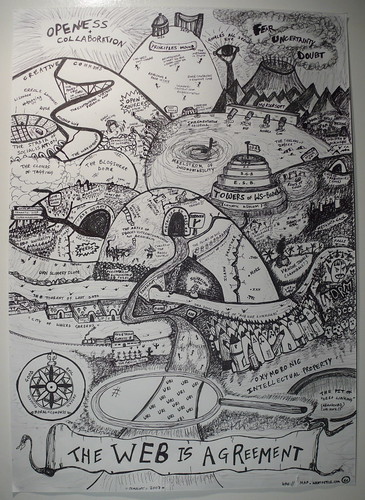Last Friday I went to my first Osmosoft Show and Tell Session. As is the way of these things, I was more into the chatter at the bar afterwards than the actual event. The bar itself was a metaphor for the change I am about to describe.
The Exchange Bar is.. an old BT telephone exchange. It was used for routing the phone calls leading to millions of Soho assignations. Today its a bar, with reasonable music, Kirin beer on draft, and half decent pizzas. The infrastructure has been transformed, as have the services offered. You can probably see where I am going with this…
BT acquired Osmosoft, the company behind a nifty, open source, Javascript-based tool called Tiddlywiki, last year. Now Osmosoft is emerging as “the open source arm” of the telco. People from the Osmosoft team develop software, but also help to socialise Open Source, helping the rest of BT to understand issues around intellectual property and so on. What does it mean to consume open source, and perhaps more importantly what are the advantages of contributing code?
Osmosoft is a social object in its own right, acquired by BT to foster a new conversation, both internally and externally. Paul Downey, now a BT “chief web services architect” is known for social objects such as this one. Its worth visiting Flickr to check out the annotated version. So who better to seed BT’s Blue Monster?
Why should BT care about open source? Why does it need a Blue Monster? For a number of reasons, not least the cost-savings available to companies building on open source foundations, and engaging with open source community collaboration models. BT’s job is to build and deliver network services, not infrastructure middleware. It can, and does, spend shareholders money on proprietary software, but it doesn’t always *have* to. Cloud computing is the latest area Osmosoft is looking at – it could spend all of its money on BEA WebLogic and Azul Systems appliances or it could try for more lightweight approaches to cloud provisioning for users. Which is where guys like Dr Pep come in.
I like to point to the Eclipse ecosystem (which used to be the Java IDE market until open source hollowed the market out) for those that haven’t understood this shared IP dynamic yet. Shared open source foundations tend to be stable foundations, and are designed for integration and repackaging.
BT is not reknowned for its speed of innovation, nor its speed of service development, but that is changing these days. One of the BT developers, Dr Pep again, told me that his dad had recently complained we wanted BT to stop innovating, because they have too many new products already. BT is in “many flowers” mode, and people like Paul and the Osmosoft team are going to help seed them.
Osmosoft will help to punch through BT’s semi permeable membrane. It will foster a developer community, particularly in the open source area. It will help BT understand the web. I am certainly going to spend more time with the Osmosoft guys in future. If nothing else they are really good company… BT’s transformation won’t be immediate, but buying outfits like Osmosoft will certainly help the transition.

Sanjay Sadhu says:
July 16, 2008 at 9:21 pm
sss